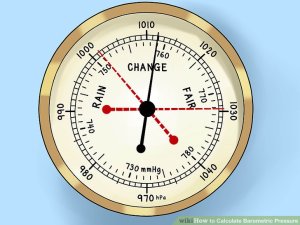A recent study by Korpon et al 2019 in Am J Otolaryngol examined barometric pressure and the incidence of benign paroxysmal positional vertigo (BPPV). The aim of this study was to determine the temporal relationship between monthly barometric pressure levels and incidence of BPPV.
The following is what the authors found:
Of all the variables studied (compared to temperature, humidity, tree/mold/grass/ragweed pollen), barometric pressure demonstrates the strongest statistically significant positive correlation, where every one unit increase in barometric pressure leads to an expected increase of 6.1 diagnoses (r = 0.66 [95% CI 0.14–0.90], p = 0.0131).
BPPV diagnoses were observed to be lowest during the summer months (June through August) with a moderate to strong, statistically significant positive correlation between BPPV diagnoses and barometric pressure observed throughout the year.
Therefore, as a clinician, you may find that BPPV diagnosis occur more often in the first of the year (say January – May), which, from this study, is most likely related to barometric pressure (compared to sunlight levels, pollen, etc).
As clinicians, what time of the year do you find BPPV to be more prevalent?
As patients, what time of the year does your BPPV “flare up”?
The authors go on to discuss correlation between BPPV and migraine, which do correlate with barometric pressure. Recently, pain and barometric pressure has just been shown to be related on an individual level (Fagerlund et al 2019). Even though the research is not strong with correlations of the weather, I would ask your patients what they think! Most do!
We notice in clinical practice that a certain percentage of patients who have BPPV have a double-entity of cervical impairments too. This can be as simple as guarding and hypertonicity of the cervical muscles due to avoidance of movements or underlying joint hypomobility and muscular impairments (strength, endurance, etc) that place the proprioceptive system at half capacity.
We do not have a ton of data on prevalence or incidence of persons having Cervicogenic Dizziness besides post-trauma (whiplash, car accident, concussion, sport injury, etc). However, we can take the above information and relate it to what we already know about time of year and barometric pressure to make correlations between ion channel sensitivity and its affect on Cervicogenic Dizziness.
Considering persons with Cervicogenic Dizziness typically have neck pain & Yacovino and Hain in 2013 determined a 4th pathophysiology for Cervicogenic Dizziness (vestibular migraine), you could potentially see a higher incidence of Cervicogenic Dizziness during the months of January – May as well. We do not have all of the answers to the association but could be based on pathophysiology of the tissues (such as in headaches, osteoarthritis or inner ear disorders) or affective states (i.e. psychosocial emotional status). Considering there is conflicting research findings on the associations, we do not fully understand the phenomena.
You can learn more about the screening and treatment process of Cervicogenic Dizzinesss through Integrative Clinical Concepts, where the authors (husband–a manual therapist a wife—a vestibular specialist), teach a very unique course combining both the theory and practice of vestibular and manual principles in their 2-day course. Pertinent to this blog post, the 2nd day includes the “Physio Blend”, a multi-faceted physiotherapist approach to the management of Cervicogenic Dizziness, which includes treatments of the articular and non-articular system of manual therapy and the most updated sensorimotor exercise regimen.
If you would like to host a course for your staff (either a vestibular, neuro, sports or ortho clinic), please do not hesitate to contact me at harrisonvaughanpt@gmail.com for more information.
Authors
Harrison N. Vaughan, PT, DPT, OCS, Dip. Osteopracic, FAAOMPT
Instructor: Cervicogenic Dizziness for Integrative Clinical Concepts
Danielle N. Vaughan, PT, DPT, Vestibular Specialist
Instructor: Cervicogenic Dizziness for Integrative Clinical Concepts
Keeping it Eclectic...














Post a Comment
Post a Comment